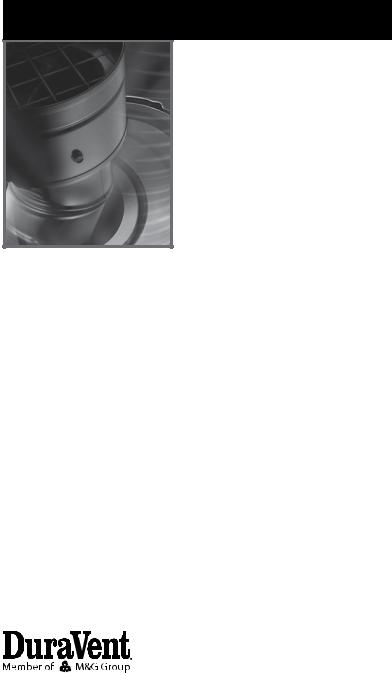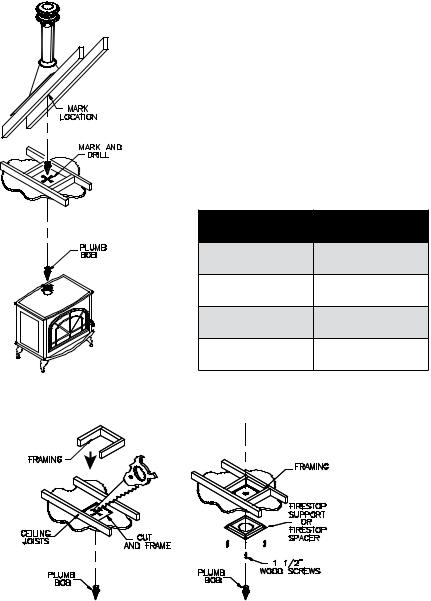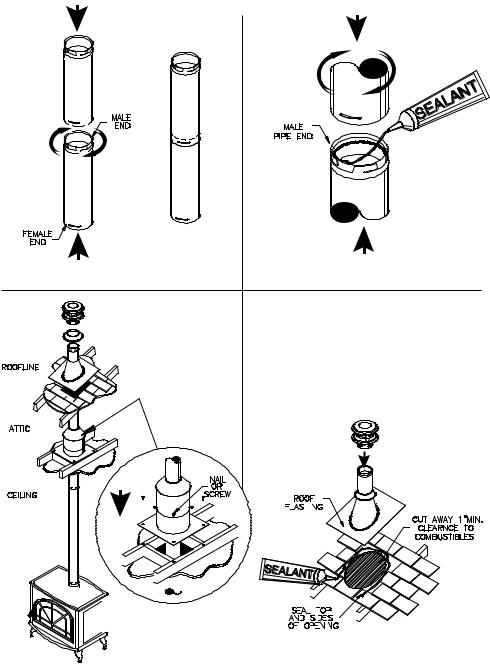DuraVent PelletVent Pro User Manual

Installation Instructions
Venting System for Pellet, Corn, Oil, and Biofuel appliances.
PROPELLETVENT

A MAJOR CAUSE OF VENT RELATED FIRES IS FAILURE TO MAINTAIN REQUIRED CLEARANCES (AIR SPACES) TO COMBUSTIBLE MATERIALS. IT IS OF THE UTMOST IMPORTANCE THAT DOUBLE WALL PELLETVENT PRO BE INSTALLED ONLY IN ACCORDANCE WITH THESE INSTRUCTIONS.
NOTE:
Read through all of these instructions before beginning your installation. Failure to install as described in this instruction will void the manufacturer’s warranty, and may have an effect on your homeowner’s insurance and UL listing status. Keep these instructions for future reference. This booklet also contains instructions for installing a venting system within an existing masonry chimney, and for installations passing through a cathedral
ceiling.
Dear Customer, Installer, or End User:
We welcome any comments regarding matters pertaining to our DuraVent products.
We welcome any ideas, input or complaints and I’ll make sure that someone responds directly back to you.
Send your emails to: president@duravent.com
If you are searching for tech support or product information, please phone us at 800-835-4429. Or email us at:
techsupport@duravent.com
LISTED MH8381 MH14420

Venting System for Pellet, Corn, Oil, and Biofuel appliances.
For the most up-to-date installation instructions, see www.duravent.com
CONTENTS
Clearances, Vent Listing, Installation Notes, Lubricants & Gaskets . . . . 4 Sealants, Fuel Selection, Best Practices . . . . . . . . . . . . . . . . . . . . . . . . . . . 5 Tools Needed, Permits, General Installation Instructions . . . . . . . . . . . . . . .6 Installation into Masonry Fireplaces . . . . . . . . . . . . . . . . . . . . . . . . . . . . . . 15 Installation Through Side of Masonry Chimney . . . . . . . . . . . . . . . . . . . . . .17 Installation in a Cathedral Ceiling . . . . . . . . . . . . . . . . . . . . . . . . . . . . . . . . . 18 Cleaning and Maintenance .. . . . . . . . . . . . . . . . . . . . . . . . . . . . . . . . . . . . . 21
PROPELLETVENT
3
CLEARANCES AND APPLICATIONS
Dura-Vent’s PelletVent Pro is listed by Underwriters Laboratories as vent for listed appliances that burn oil, pellet, corn, and other biofuels. PelletVent Pro is also listed as a masonry reliner with the minimum clearance is 0” from vent to masonry, and 0” clearance from the masonry to nearby combustibles. Never fill any required clearance space with insulation or any other materials. Combustible materials include (but are not limited to) lumber, plywood, sheetrock, plaster and
lath, furniture, curtains, electrical wiring, and building insulation of any kind.
In the United States and Canada the minimum clearance to combustibles from PelletVent Pro is 1” for oil, pellet, corn or other biofuel applications.
VENT LISTING
PelletVent Pro is listed by Underwriters Laboratories (listing numbers MH8381 & MH14420) to the American standard UL 641 Type L Low Temperature Venting Systems, and is also listed to the Canadian standards ULC S609 Standard for Low Temperature Vents Type L and ULC/ORD-C441 Standard for Pellet Vents .
INSTALLATION NOTES
Proper planning for your PelletVent Pro installation will result in greater safety, efficiency, and convenience, saving both time and money. Use only authorized Dura-Vent PelletVent, CornVent, and PelletVent Pro biofuel listed parts. Do not install damaged parts.
1. WARNING: When passing through ceilings and walls, make sure all combustible materials
and building insulation products are a minimum of 1” from the vent pipe
2.For horizontal terminations, make sure NFPA 211 rules are followed for minimum distance from windows and openings.
3.Do not mix and match with other manufacturer’s products or improvised solutions.
4.Practice good workmanship. Sloppy work could jeopardize your PelletVent Pro installation.
5.Never use a vent with an inside diameter that is smaller than the appliance flue outlet.
6.Multistory: Where PelletVent Pro passes through the ceiling, use Dura-Vent Firestop/ Support assembly.
7.PelletVent Pro placement: When deciding the location of your stove and vent, try to minimize the alteration and reframing of structural components of the building.
8.Sections of pipe are connected to each other by pushing them firmly together and twisting. Screws are not required. However, if screws are desired, use 1/4”-long sheet metal screws. Important! Do not penetrate the inner liner with screws.
9.Never install single-wall pipe to freestanding pellet stoves. Single-wall pipe may be connected to a fireplace insert, provided it
is inside the fireplace, and the fireplace has completely sealed surroundings.
10.Do not connect Type B Gas Vent pipe with aluminum liners to pellet appliances.
LUBRICANTS & GASKETS
PelletVent Pro utilizes an internal O-ring gasket on the outside of the inner liner in the female end of the Pipe Section. These gaskets are lubricated and help seal Pipe Sections as they are connected together. If your O-ring gasket is missing or it becomes unseated during connection, you must replace and
4
lubricate the new O-ring gasket. Replacement gaskets and silicone lubricants are available to order from the PVP catalog or our website at duravent.com.
SEALANTS
PelletVent Pro does not require additional sealant to be used at pipe joints, but in certain circumstances sealant may be used if desired. Seal the inner liner overlap at the male end of pipe for best results (Figure 6)
Note: 500ºF RTV silicone sealant is required on the following component connections:
•Connecting PelletVent Pro biofuel (with gaskets) to PelletVent
Pro (without gasket) or another PelletVent or CornVent.
•Connecting Appliance Adapter or any other part when connecting to the appliance outlet
•When using the Adjustable Length section.
FUEL SELECTION, BEST PRACTICES
PelletVent Pro is a multi-fuel venting system approved for burning wood pellets, corn, and other approved biofuels, plus, oil and kerosene. Be sure to follow the recommendations of the appliance
manufacturer for the burning of corn or other types of biofuel. A major reason for accelerated vent corrosion from burning corn is due to acidic condensate forming in the system.
The moisture content of corn contributes significantly to condensate in the vent. The lower the moisture content of the corn, the less condensate you are likely to have in the vent. While corn with a moisture content of 15% may be allowed in the appliance, using a fuel with lower moisture content will help reduce condensate formation.
Vent Runs: Condensate is more likely to form in longer vents because the exhaust temperature cools further away from the appliance. If the exhaust cools to a certain point, moisture in the exhaust condenses in the vent, which can lead to accelerated vent corrosion. Keep the vent for cornburning appliances short wherever possible to maintain hot flue gas temperatures and
keep moisture suspended in the exhaust. If a longer horizontal vent or taller vertical vent is needed, it is recommended that the vent run inside the building envelope or inside a chase enclosure to minimize the vent’s exposure to cold temperatures. When terminating a corn burning system horizontally a stainless steel outer Pipe Section and the Round Horizontal Termination Cap are required. Be sure to follow all other applicable building codes and maintain all minimum clearances in enclosures.
Appliance Operation: Regardless of the fuel you choose always operate your appliance in accordance with the appliance manufacturer’s recommendations. If you burn corn, operating the appliance at its lowest setting has a greater chance for condensate to form in the vent due to the low exhaust temperature. In order to help reduce condensate from forming inside the vent system, operate the appliance at higher temperatures when colder weather is encountered. Higher operation settings provide for warmer flue temperatures, which help to keep moisture suspended in the flue gases.
Inspection and Maintenance: When burning corn, be sure to inspect the appliance and vent often to determine if there has been any corrosion or damage to the system. Be sure to keep the venting system clean, including the tee cap (if applicable). The ash that results from burning corn can trap condensate in the tee cap and inside the vent, hastening
5

corrosion to the system if left unchecked. Using pelletized fuel does not eliminate the need for inspection and cleaning. Lesser quality pellets create more soot accumulation and can clog venting sooner than the cleaner burning pellets. While it is not necessary to clean out liquid fuel burning systems with a brush, all other systems should be visually inspected monthly during the heating season, and cleaned at least once a year
TOOLS AND EQUIPMENT YOU MAY NEED
Eye Protection Gloves Screwdriver Hammer
High-Temperature Waterproof (RTV) Sealant Tape Measure
Saber or Keyhole Saw Level and Plumb bob
 PELLET VENT PRO
PELLET VENT PRO  PIPE
PIPE
PERMITS
Contact your local building department or fire officials regarding any needed permits, restrictions, and installation inspection requirements in your area.
GENERAL INSTALLATION INSTRUCTIONS
PelletVent Pro is listed with a minimum 1” clearance to combustibles
1. Follow the stove/appliance manufacturer’s instructions.
A.Choose an appliance that is listed by a recognized testing laboratory.
B.Connect only one flue per appliance.
C.Only burn fuels approved for use by your appliance manufacturer.
Figure 1
D. Follow the appliance manufacturer’s instructions and safety manual for maximum efficiency and safety. Over firing can damage the appliance and vent.
2. If the vent exit is on top of the stove
(Figure 1):
A.Place the appliance according to the manufacturer’s instructions.
B.Drop a plumb bob to the center of the appliance flue outlet and mark center point on
6

the ceiling (Figure 2). At your marked center point, cut and frame a square hole in the ceiling for installation of the Ceiling Support or Firestop Spacer (Figure 3). Refer to Table 1 for the dimensions of the hole.
C. Connect Pipe Adapter or Increaser Adapter to stove: Due to the variety of different stove collars, the Pipe Adapter will need hightemperature non-hardening sealant in order to achieve a leak-free connection. .
D. Connect Pipe Sections. Attach PelletVent Pro Pipe Sections by pushing male and female ends of pipe together and twisting until pipe is in locked position (Figure 4). PelletVent
|
PelletVent Pro |
Framing Dimensions |
|
Component |
|
|
|
|
|
3" & 4" Ceiling Support / |
7" x 7" |
|
firestop spacer |
|
|
|
|
|
3" & 4" cathedral ceiling |
10 ¾" x 10 ¾" |
|
support box |
|
|
|
|
|
3" & 4" wall thimble |
7 ½" x 7 ½" |
|
3" & 4" CAS wall thimble |
|
|
|
|
|
3" & 4" wall thimble AiR |
9" x 9" |
|
intake kit |
|
|
|
|
Figure 2 |
Table 1 |
|
Figure 3
7

Figure 4 |
Figure 5 |
|
|
|
|
|
|
|
|
|
|
|
|
|
|
|
|
|
|
|
|
|
|
|
|
|
|
|
|
|
|
|
|
|
|
|
|
|
|
|
|
|
|
|
|
|
|
|
|
|
|
|
|
|
|
|
|
|
|
|
|
|
|
|
|
|
|
|
|
|
|
|
|
|
|
|
|
|
|
|
|
|
|
|
|
|
|
|
|
|
|
|
|
|
|
|
|
|
|
|
|
|
|
|
|
|
|
|
|
|
|
|
|
|
|
|
|
|
|
|
|
|
|
|
|
|
|
|
|
|
|
|
|
|
|
|
|
|
|
|
|
|
|
|
|
|
|
|
|
|
|
|
|
|
|
|
|
|
|
|
|
|
|
|
|
|
|
|
|
|
|
|
|
|
|
|
|
|
|
|
|
|
|
|
|
|
|
|
|
|
|
|
|
|
|
|
|
|
|
|
|
|
|
|
|
|
|
|
|
|
|
|
|
|
|
|
|
|
|
|
|
|
|
|
|
|
|
|
|
|
|
|
|
|
|
|
|
|
|
|
|
|
|
|
|
|
|
|
|
|
|
|
|
|
|
|
|
|
|
|
|
|
|
|
|
|
|
|
|
|
|
|
|
|
|
|
|
|
|
|
|
|
|
|
|
|
|
|
|
|
|
|
|
|
|
|
|
|
|
|
|
|
|
|
|
|
|
|
|
|
|
|
|
|
|
|
|
|
|
|
|
|
|
|
|
|
|
|
|
|
|
|
|
|
|
|
|
|
|
|
|
|
|
|
|
|
|
|
|
|
|
|
|
|
|
|
|
|
|
|
|
|
|
|
|
|
|
|
|
|
|
|
|
|
|
|
|
|
|
|
|
|
|
|
|
|
|
|
|
|
|
|
|
|
|
|
|
|
|
|
|
|
|
|
|
|
|
Figure 6 |
|
|
|
|
|
|
|
|
|
|
|
|
Figure 7 |
|||||||||||||||
8
